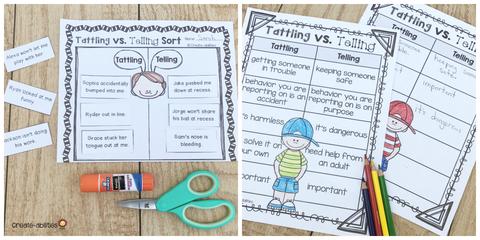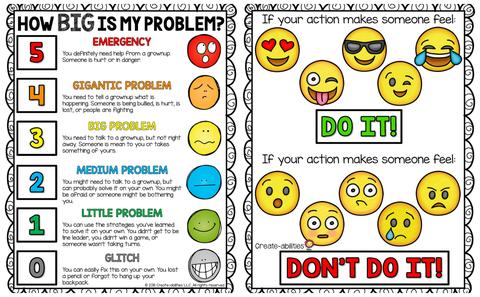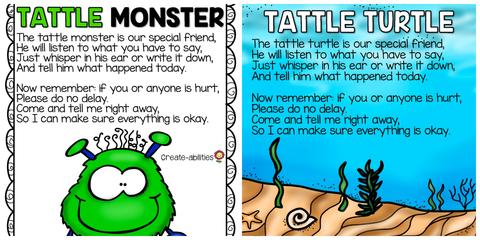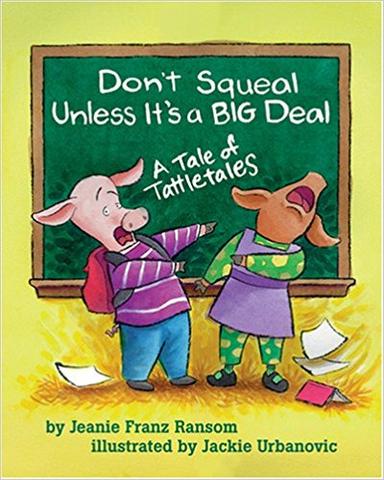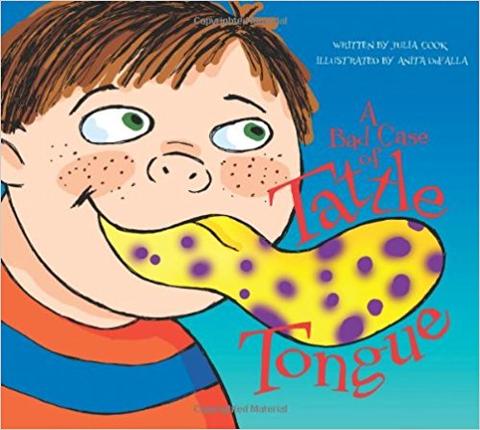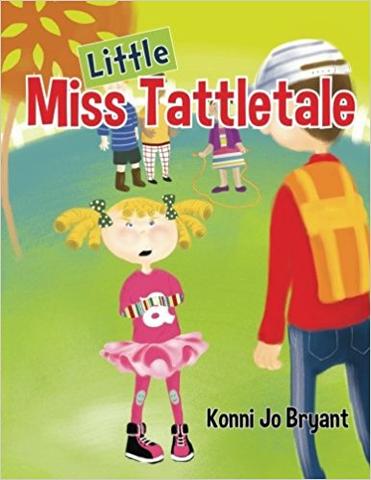
Tackling Tattling in the Classroom
“Jackson cut in line!”
“Olivia said a bad word!”
“Kiara pushed me!”
It seems like every day there is an endless stream of students reporting behaviors or incidents that happen in the classroom. On one hand, we want to help our students feel heard and validated so they know we are a safe person for them to talk to. On the other hand, we certainly don’t want to feed into the tattle machine. It’s a fine line to walk. So how do we handle tattling in our classrooms?
The Responsive Classroom brings this problem to light by illustrating for us the dangers of discouraging all tattling and thereby creating a “culture of silence.”
They write, “Such inadvertent but powerful messages clearly work against the culture of emotional and physical safety we want to establish for our children. Frequently we see reports of school officials who uncover bullying and learn that many students knew of prior incidents involving the same children. But the witnessing children told no one, and their silence emboldened those experimenting with bullying to go even further. We are often surprised by children’s silence in these cases, but we shouldn’t be. Often they’re simply following the ‘no tattling’ rule they learned at home or in school at a young age.”
So, instead of silencing tattling altogether, we can begin to look at tattling in a new way.
Why Do Children Tattle?
1. To gain favor, exert power, boost self-esteem, or just get attention. Child Psychologist Jerry Wyckoff wrote, “Tattling allows a child to one-up another child, to gain favor in the eyes of her parent or teacher.”
2. Testing Limits and Boundaries. Some students want to see if you are consistent in enforcing the rules. They may also be testing to see if they will be heard or brushed off with a “Stop tattling.”
3. Limited Problem-Solving Skills: Students in our classroom often don’t have the skills they need to deal with the problems they face. They might not know how to respond in a certain situation. Simply telling them not to tattle doesn’t give them the skills they need to solve the problem.
4. Legitimate Concerns: Students face problems that affect their life and the lives of their friends. What may seem trivial to us can be a big deal to them. Always brushing it aside as tattling can create a climate of silence.
What To Do About Tattling
1. Explain the difference between tattling and reporting. Explicitly explain what a tattle is (trying to get someone in trouble) and what reporting is (trying to keep someone safe or out of trouble.) They should report significant events-those that threaten someone’s physical or emotional safety. You can tell them that if they are unsure if something is significant, they should come and tell you. They will continue to learn what is significant and what isn’t as you follow this process.

2. Practice what situations should be reported. Role playing is a powerful tool. Create a T-chart with your students to talk about what should be reported, what they can handle on their own, and what they can let go.
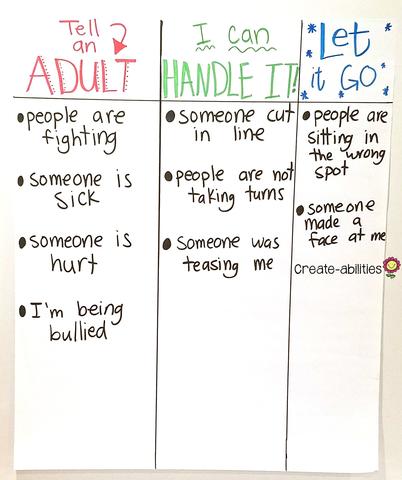
Another good way to practice is to have them write about or sort different scenarios. This helps to reinforce what should be reported and what is a tattle. (If you are interested in the pages below, you can find them as part of my Bullying and Kindness pack.)
Finally, having different posters displayed for students to refer back to can help them remember what is appropriate to report.
3. Give students opportunities to report to you. Let students know when it is an appropriate time to report to you. It is also a good idea to let them report to you privately. You can have them speak to you, write you a note, or write about what happened in a conversation journal. A conversation journal is a notebook where the student and teacher correspond weekly or bi-weekly. This is a great outlet for concerns and can help you look out for issues before they arise.

Many people have tried using things such as tattle phones, tattle monsters, and tattle turtles. I think as long as students feel like they are being heard and respected, any method of letting them report is appropriate.
4. Teach conflict resolution skills. If you teach some important social skills, students will begin to learn how to handle situations themselves. Those skills include:
- Cooling off when upset
- Speaking directly to each other
- Speaking assertively, honestly, and kindly
- Listening carefully to each other (they can also paraphrase each other’s words to ensure understanding)
- Proposing solutions and agreeing on a solution to try
Again, role playing can be a powerful teaching tool in this situation. Acting out how students should talk to their peers is an important teaching moment.
5. When students report, take time to understand the situation. Make sure you are fully aware of the circumstances the student is trying to tell you. That can help you decide whether to step in and enforce a rule, give them a strategy to try and problem-solve on their own, or just make the student feel heard and then move on.
6. Be ready with a few respectful responses to tattlers. It is usually better if you can respond to a student in a positive way. This is not always easy (especially when a student feels they have to interrupt your math lesson to report someone sitting in the wrong spot.) Remember that when we see or experience something that we feel is adversely affecting us, breaking the rules, or hurting someone we care about, we often seek out a colleague or family member to talk to. Our students are learning how to do that.
Try to think about what the student could really be saying: “This is important to me. Hear me. Help me.” If we brush them off with a quick “Stop tattling!” we are teaching them not to come to us if something isn’t right.
Some respectful ideas include:
- “Thank you for telling me. I’ll try to watch close next time.”
- “Wow you really know our rules!”
- “Thank you for telling me. Why don’t you write about it in your journal and tell me more?”
- “Why don’t you draw a picture about how it made you feel?”
Often times if we give the tattler some “work” to do when they tattle, it will cut down on the frequency. If they have to always write a paragraph about what happened or draw a picture, they might decide the time and effort aren’t worth it.
7. Reinforce and praise students who report serious incidents. Depending on your situation, you can do this privately or publicly. Tell the student that it took courage to report a serious situation and that you are proud of them for trying to help someone else.
If you would like to get some of our Tattling Classroom Resources for free, we can email them to you, or you can download them from the ‘Files’ section of our Create-abilities Teacher Community Facebook Group. If you haven’t joined the group yet, it’s a great way to stay up-to-speed on everything Create-abilities, including product announcements, sales, freebies, live broadcasts, giveaways, and more!
Books I Love That Help With Tattling
Picture books can be a great way to teach students how to deal with tattling. Here are some of my favorites. Just so you know, they are affiliate links.
1. Don’t Squeal Unless It’s a Big Deal
2. A Bad Case of Tattle Tongue
4. Help Me Be Good About Tattling
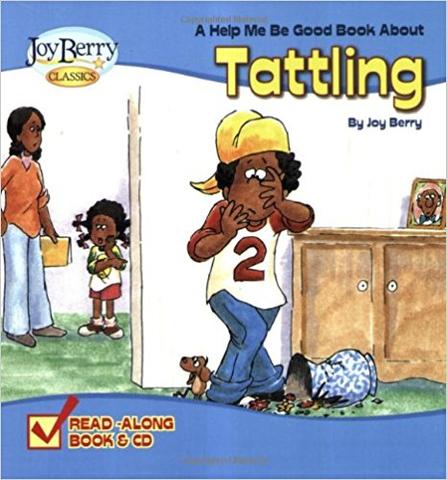
Tattling can be a frustrating issue to deal with. As you try these ideas in your room, you’ll learn your own ways to keep things running smoothly and peacefully without creating a “culture of silence.”
Blog Categories
Meet the author


